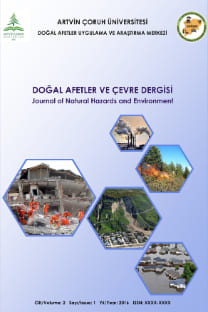Yeni Türkiye Bina Deprem Yönetmeliğine Göre Zeminlerin Sıvılaşma Analizi ve Sıvılaşmaya Karşı İyileştirilmesi
Liquefaction Analysis of Soils according to the New Turkish Building Earthquake Code and Improvement against Liquefaction
___
- Baez J.I., (1995), A design model for the reduction of soil liquefaction by vibro-stone columns, Doktora Tezi, The University of Southern California, USA.
- Boulanger R.W., Idriss I.M., (2014), CPT and SPT based liquefaction triggering procedures, Report No. UCD/CGM-14/01, Center for Geotechnical Modeling, University of California at Davis, 138ss.
- Bray J.D., Dashti S., (2010), Liquefaction-induced movements of buildings with shallow foundations, International Conferences on Recent Advances in Geotechnical Earthquake Engineering and Soil Dynamics, Paper No. OSP 2, 24-29 May, San Diego, California.
- Bray J.D., Sancio R.B., Durgunoglu H.T., Onalp A., Youd L., Stewart J.P., Seed R.B., Cetin K.O., Bol E., Baturay M.B., Christensen C., Karadayilar T., (2004), Subsurface characterization at ground failure sites in Adapazari, Turkey, Journal of Geotechnical and Geoenvironmental Engineering, 130(7), 673-685.
- Cetin K.O., Seed R.B., Der Kiureghian A., Tokimatsu K., Harder L.F., Kayen R.E., Moss R.E.S., (2004b), Standard penetration testbased probabilistic and deterministic assessment of seismic soil liquefaction potential, Journal of Geotechnical and Geoenvironmental Engineering, 130(12), 1314-1340.
- Cetin K.O., Youd T.L., Seed R.B., Bray J.D., Stewart J.P., Durgunoglu H.T., Lettis W., Yilmaz M.T., (2004a), Liquefaction-induced lateral spreading at Izmit Bay during the Kocaeli (Izmit)-Turkey earthquake, Journal of Geotechnical and Geoenvironmental Engineering, 130(12), 1300-1313.
- Durgunoğlu H.T., (2004), Yüksek modüllü kolonların temel mühendisliğinde kullanımı, Türkiye Mühendislik Haberleri, 431, 39-52.
- Idriss I.M., Boulanger R.W., (2008), Soil liquefaction during earthquakes, Earthquake Engineering Research Institute, EERI Publication, Monograph MNO-12, Oakland, CA, 237ss.
- Idriss I.M., Boulanger R.W., (2010), SPT-based liquefaction triggering procedures, Report No. UCD/CGM-10/02, Center for Geotechnical Modeling, University of California at Davis, 259ss.
- Liao S.S.C., Whitman R.V., (1986), Overburden correction factors for SPT in sand, Journal of Geotechnical Engineering, 112(3), 373- 377.
- Mollamahmutoglu M., Kayabali K., Beyaz T., Kolay E., (2003), Liquefaction-related building damage in Adapazari during the Turkey earthquake of August 17, 1999, Engineering Geology, 67, 297-307.
- Ozener P., Dulger M., Berilgen M., (2015), Numerical study of effectiveness of jet-grout columns in liquefaction mitigation, 6th International Conference on Earthquake Geotechnical Engineering, Christchurch, New Zealand.
- Özsoy B., Durgunoğlu T., (2003), Sıvılaşma etkilerinin yüksek kayma modüllü zemin – çimento karışımı kolonlarla azaltılması, 5. Ulusal Deprem Mühendisliği Kongresi, Bildiri No: AT-004, 26-30 Mayıs, İstanbul.
- Rayamajhi D., Nguyen T.V., Ashford S.A., Boulanger R.W., Lu J., Elgamal A., Shao L., (2014), Numerical study of shear stress distribution for discrete columns in liquefiable soils, Journal of Geotechnical and Geoenvironmental Engineering, 140(3), 04013034: 1-9.
- Seed H.B., Idriss I.M., (1971), Simplified procedure for evaluating soil liquefaction potential, Journal of the Soil Mechanics and Foundations Division, 97(9), 1249-1273.
- Sivrikaya O., Toğrol E., (2009), Arazi deneyleri ve geoteknik tasarımda kullanımları, Birsen Yayınevi, İstanbul, 280ss.
- TBDY, (2018), Türkiye Bina Deprem Yönetmeliği, Resmi Gazete, Tarih: 18.03.2018, Sayı: 30364.
- Youd T.L., Idriss I.M., Andrus R.D., Arango I., Castro G., …, Stokoe K.H., (2001), Liquefaction resistance of soils: Summary report from the 1996 NCEER and 1998 NCEER/NSF workshops on evaluation of liquefaction resistance of soils, Journal of Geotechnical and Geoenvironmental Engineering, 127(10), 817-833.
- ISSN: 2528-9640
- Yayın Aralığı: Yılda 2 Sayı
- Başlangıç: 2015
- Yayıncı: Artvin Çoruh Üniversitesi Doğal Afetler Uygulama ve Araştırma Merkezi
Bitlis Hava Kirliliği Emisyon Envanteri ve Sağlık Etkilerinin Çoklu Lineer Regresyonla Tahmini
Atık Andezit Tozu ve Uçucu Küllerin Betonda Kullanımının Karşılaştırılması
Situation of the Yukarıköy’s Traditional Stone Masonry Houses Affected by 2017 Ayvacık Earthquakes
Ali Rıza PARSA, Ali Osman KURUŞCU
Erzincan Kentinde Yerel Zemin Özelliklerinin Deprem Duyarlılığına Etkisi
Bir Hastanede İç Hava Kalitesinin Araştırılması: Şanlıurfa’dan Örnek Bir Çalışma
Kahramanmaraş Domuz (Boğaz) Deresi Kuşaklama Kanalının HEC-RAS Modeli
Burcu ERCAN, Ayşe ECE YAĞCI, MEHMET ÜNSAL
Uzun ve Kısa Süreli Periyotlarda Kuraklık Analizi: Bursa Örneği
Ülker GÜNER BACANLI, Pınar GÖKÇE KARGI
Büyük Menderes Grabeninde Cisim Dalgalarının Frekans Bağımlı Soğrulma Karakterinin Belirlenmesi
2017 Ayvacık Depremlerinden Etkilenen Yukarıköy Geleneksel Taş Evlerinin Durumu
